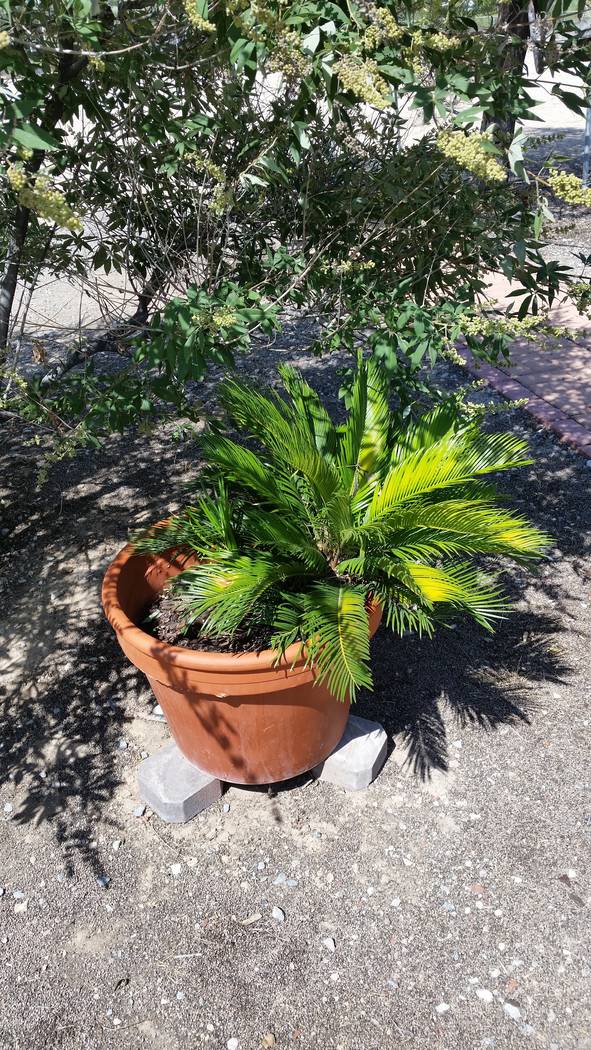Wet soil or mulch against tree trunk can cause collar rot

Q: The leaves on my fig tree appear burned after this rain. I foliar sprayed it with neem oil and soap and fish protein isolate. These trees were planted last fall and mulched with 1 foot of woodchips and looked amazing until now. They are watered three times each week in the summer.
A: The leaves look like they are diseased. But I have a saying: “When the top looks bad, look at the ground.” Eliminate the easy problems before jumping to more difficult ones.
I wonder if that 12 inches of surface mulch is rotting the trunk of the tree. It is easy to kill young trees if they sink into the planting hole after planting. Or if woodchip mulch on the soil surface is piled against the trunk and kept wet.
In both cases, wet soil or wet mulch against the trunk can cause a disease called collar rot. The disease rots the trunk and chokes the top of the tree. When this happens, leaves look diseased or not getting enough water. This becomes very apparent during hot weather.
Start on your knees and pull the mulch away from the trunk. Keep it there permanently, 6 to 12 inches away. Next, carefully remove the soil from around the trunk until you find tree roots coming from the trunk growing horizontally.
If this small area of the trunk looks water-soaked, there might be a problem. I take a penknife and cut away a narrow strip of the trunk that was buried in soil and mulch. The wood under the strip should be white or greenish white.
If there is more than a half-inch of soil covering the trunk, or the trunk was buried in wet mulch, the tree may develop collar rot. All you can do is let the covered part of the trunk air dry and hope for the best.
I have seen collar rot develop on the lower trunk of young figs and pomegranate that are buried. Most figs and pomegranates are grown on their own roots. If the top of the tree dies, wait a couple of months and see if anything suckers from the roots or base of this tree. If it does, don’t replace the tree.
These basal suckers will grow very rapidly into a new tree because the tree already has established roots. When one of the suckers is 12 inches tall, remove the others for a single trunk tree or select three to five for a multitrunk tree.
It’s possible these leaf problems are related to a leaf disease, but I don’t recognize it. Sometimes when dead areas develop from disease pathogens, the dead area is bordered by yellow. This yellowing is where the plant tissue is still dying. Sometimes this yellowing doesn’t exist but only because the disease has stopped spreading.
The humidity in Las Vegas is unusually high right now because of the summer monsoon and rains. I expect diseases to pop up during this kind of weather. Having leaf diseases on fruit trees would not be uncommon during this time of year.
Instead of spraying, try using a passive approach toward controlling diseases. Remove extra leaves that might be blocking the movement of air and wind through the canopy. As you see leaf diseases, remove the infected leaves and dispose of them. The plant will grow new leaves in places where there is sunlight. Leaf diseases slow down or stop as the weather changes.
Q: The cycad I bought in a container a few years ago is turning yellow even though I moved it out of direct sun and into the dappled shade of a vitex tree. Can you advise whether I still need more shading to correct the yellowing? I’m afraid to plant it in the ground because it might freeze.
A: I don’t think the yellowing is a problem from intense sunlight. This plant can handle full sun in our Mojave Desert with no problems if the soil has been prepared adequately, organic amendments are added to the soil every year or two and water is available when needed. It’s easier to grow, however, on the east side of buildings where it gets some protection from the late afternoon sun.
From your picture, it seems it is growing in the same container that came from the nursery. If this is true, all the organics in that original soil are gone. Even if you are adding fertilizer to the container, the plant leaves yellow because the soil is worn out. Basically, the plant is growing in the container hydroponically (only water and whatever fertilizer it gets).
It is important to add organic amendments to all soils on a regular basis to maintain good plant health, improve its tolerance to our harsh desert climate and ensure plants are resistant to diseases.
Plants grow better and are healthier (they can withstand more problems) if they are grown in the ground and in a healthy manner. Your cycad is growing in old, tired soil that has not been amended in a container that’s too small, and who knows if it’s getting water when needed?
Pick a spot for it and get it planted. Plants growing in containers are difficult to manage. In the ground, it can grow in full sun if surrounded by other irrigated plants. This plant will be healthier if the soil is covered with woodchips rather than rock. It is not a desert plant for sure, so it needs to be planted and watered with other nondesert plants and cared for in a nondesert way.
These plants will tolerate temperatures as low as 20 degrees but may show some winter damage (bronzing) to the leaves at 25 degrees. Remember, winter cold is worse if the plant is growing in a windy location.
When planting it this fall, use a quality compost and mix it equally with soil taken from the planting hole. Use this amended soil and flood the hole with water as the soil is added. Make sure it’s planted at the proper depth — not too shallow nor too deep.
Cover the soil surrounding it with woodchips from local trees trimmings. These will degrade over time and add more organics to the soil. Your cycad will appreciate this.
Fertilize it lightly once a year with a tree, shrub or lawn fertilizer. Apply it under the leaves, not too close to the trunk, and water it in.
Leaves that are yellow will stay yellow until removed in a couple of years, when the plant gets older and bigger. But the new growth coming from the trunk should be dark green if planted correctly. This new growth eventually replaces yellow leaves as they are removed.
Water the same as you would other trees and shrubs in the landscape. Apply 5-10 gallons of water each time it is irrigated.
Q: I found many holes scattered in bare ground at one of the properties I maintain. The holes are small, perhaps the size of a penny. I hope you can help me identify what could be doing this. I don’t want to hurt any pollinators.
A: It’s mid-July now, and I have been hearing the buzz to attract females from male cicadas since around the first of the month. I think what you are seeing are emergence holes of cicadas. The immature cicada grub lives underground and feeds on tree roots such as ash.
Most people know the 17-year periodical cicadas, but there are other cicadas that emerge every year. The cicadas are nicknamed “dog day cicadas” or annual cicadas because they emerge every year during the heat of summer.
That buzzing noise is used to attract females for mating and eventual laying of eggs. The eggs of cicadas are inserted by females into slits cut into small tree branches. Sometimes the small branches die from the damage caused by an egg-laying combined with the heat of the summer.
The eggs hatch and the small young drop to the ground, where they dig deep into the soil to find plant roots, sometimes as much as 6 to 8 feet below the surface. They have powerful front legs modified for digging deeply into the soil to find roots for food and water.
You should be able to see their empty discarded skins split open on tree trunks, the sides of buildings and other structures. I wouldn’t worry about them, but I expect it’s important to remove cast skins when you see them because of aesthetics.
I have never heard of anyone controlling them because of plant damage.
Bob Morris is a horticulture expert and professor emeritus of the University of Nevada, Las Vegas. Visit his blog at xtremehorticulture.blogspot.com. Send questions to Extremehort@aol.com.



















